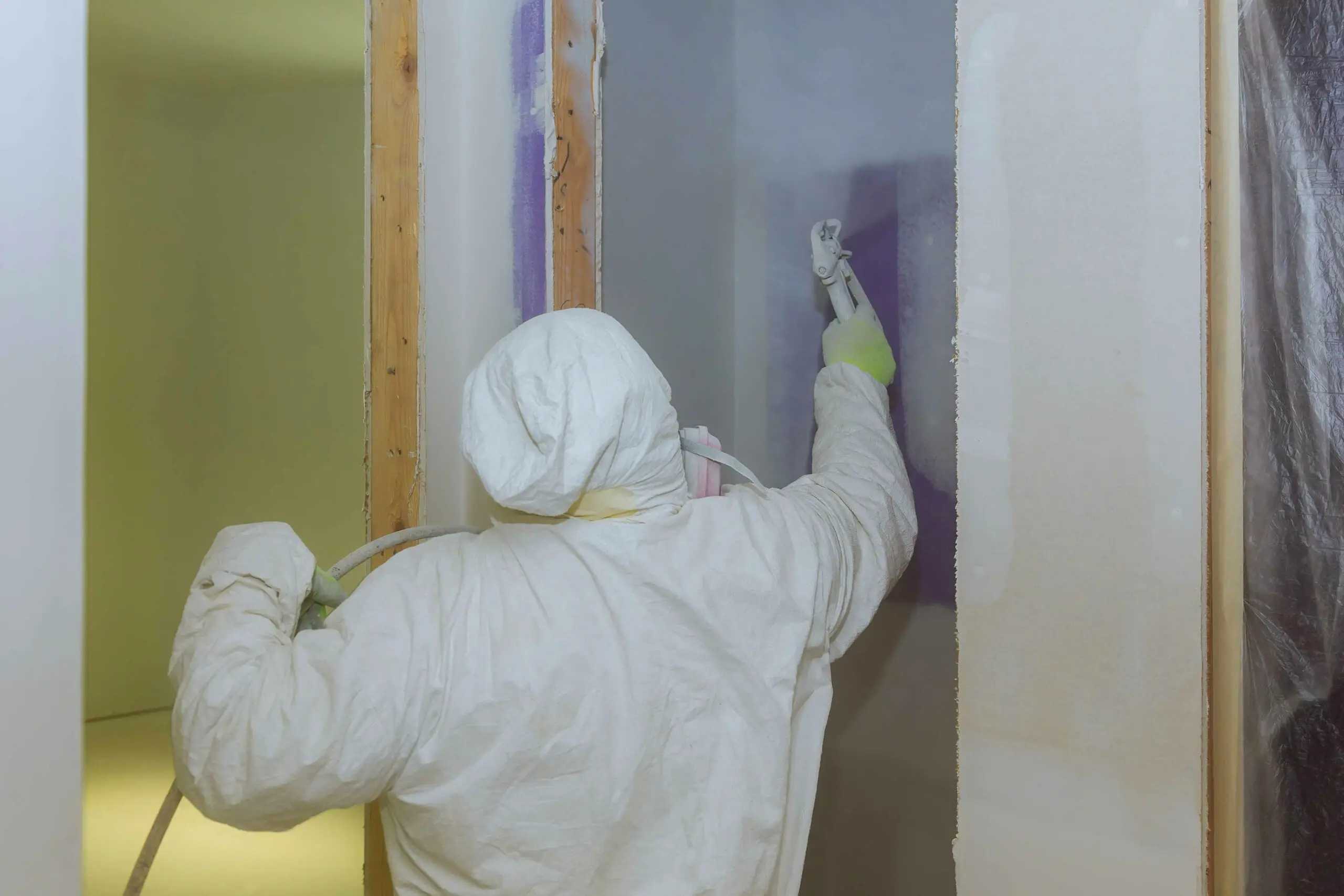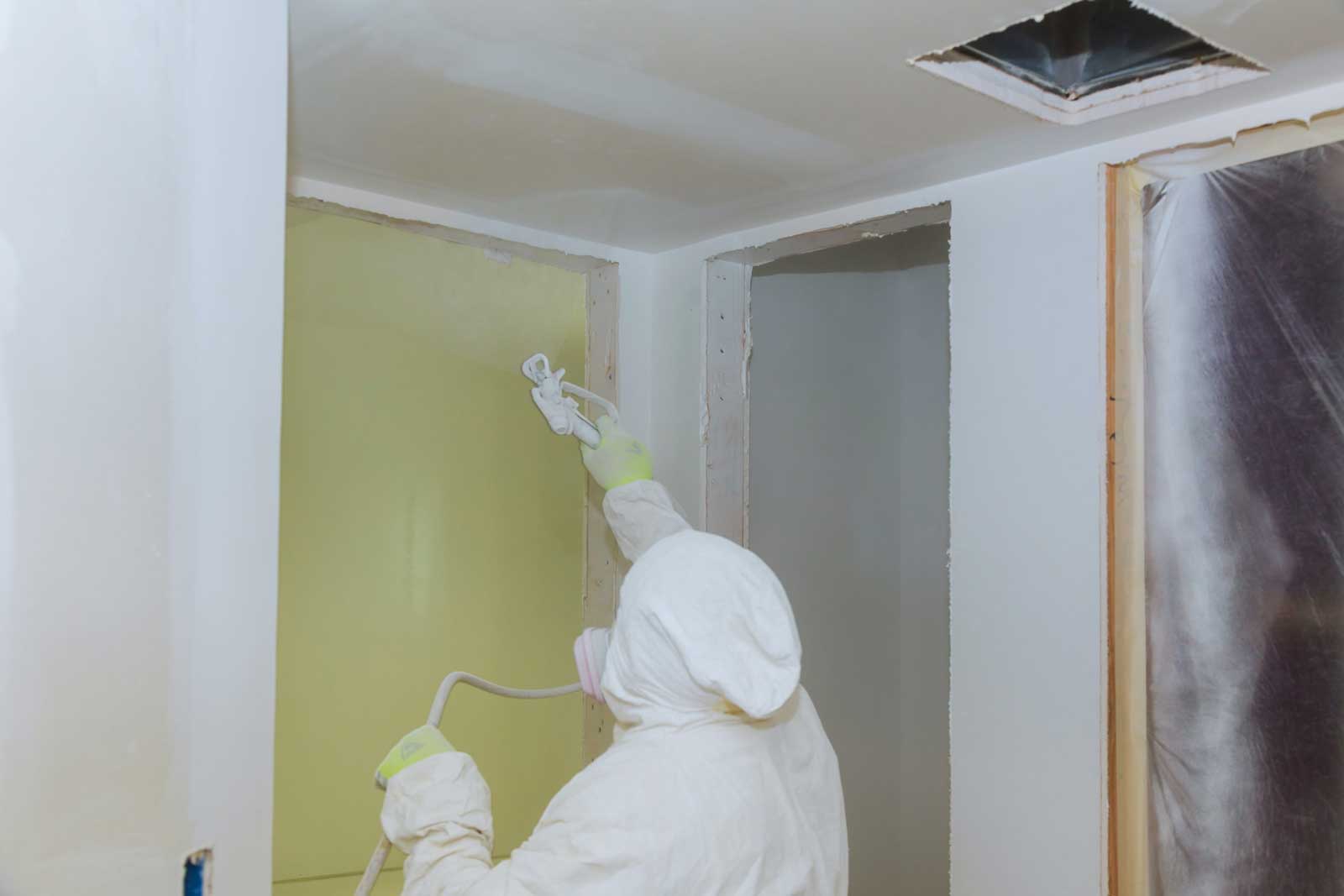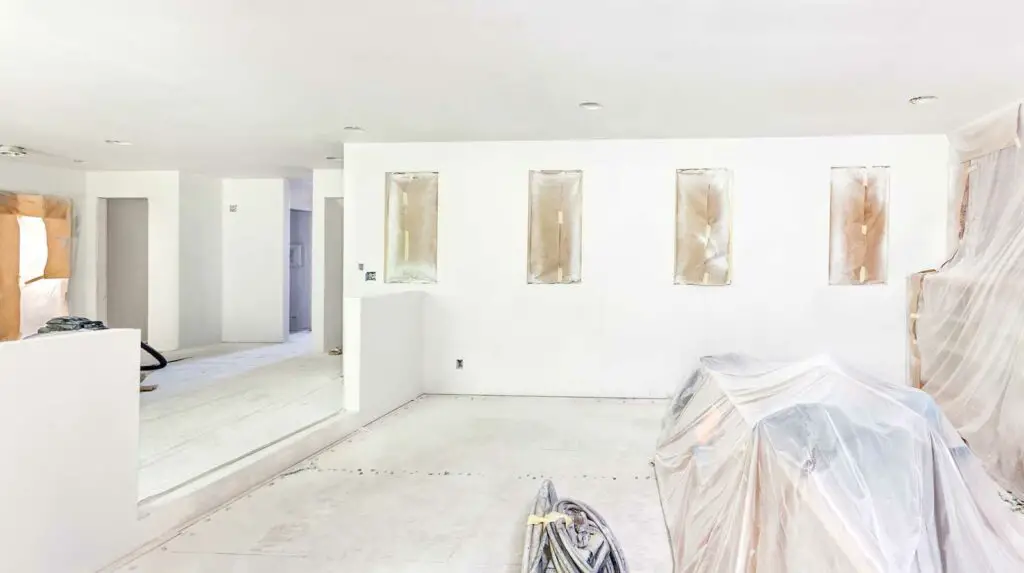Are you tired of watching paint dry – literally? In this guide, we’re here to help you figure out exactly how long spray paint primer takes to dry, so you can plan your painting projects more efficiently.
So how long does it take for spray paint primer to dry?
Spray paint primer typically dries in 1-4 hours depending on various factors like primer type, temperature, and humidity.
In this guide, we’ll break down the types of primers, their drying times, and share valuable tips to ensure your painting projects go smoothly and to help you achieve that flawless finish.
By the way – before we get too far along here, if you want to connect with other homeowners, DIYers, and builders and get more great ideas for your home to make your space the best join my free private Facebook group, Remodel Reality here.
 Types of Primers and Their Drying Times
Types of Primers and Their Drying Times
Ever wondered how long it takes for spray paint primer to dry? You’re not alone. Understanding the drying times of different primers can greatly impact the quality of your paint job. In this section, we’ll cover the types of primers and their drying times to help you achieve that perfect smooth finish.
Oil-Based Primers
When it comes to oil-based primers, patience is key. These primers offer excellent adhesion and are great for use on wood and metal surfaces. However, they can take anywhere from 1 to 24 hours to dry completely (source). Make sure to allow ample time for drying before moving on to the next step in your painting project.
Latex Primers
Looking for a faster drying time? Latex primers might be your answer. These water-based primers are often used on a variety of surfaces, from wood to plastic. They usually take about 1 to 4 hours to dry (source). As always, it’s important to follow the manufacturer’s instructions on the label for best results.
Comparison of Popular Primers
Two popular primer brands you might have come across are Kilz and Rustoleum. Both offer a wide range of primer options, including oil-based and latex variants. While the drying times might vary slightly between these brands, following the guidelines mentioned earlier should steer you in the right direction.
Different Types of Spray Paint
Not all spray paints are created equal. There’s a wide array of options, such as lacquer, enamel, epoxy, and even water-based spray paints (source). The type of spray paint you choose will also affect the drying time and the overall finish, so choose wisely.
Kind of Surface
The surface you’re working on plays a crucial role in the primer’s drying time. For example, metal surfaces usually take longer to dry compared to wood or plastic. So, be prepared to wait a little longer if you’re working on a metal project.
Type of Spray Paint
Aside from the type of primer, the type of spray paint you choose will also impact the drying time. As mentioned earlier, water-based spray paints tend to dry faster than oil-based ones. So, if you’re in a hurry, you might want to opt for a water-based spray paint to speed up the process.
Best Way
Applying a thin layer of primer is always the best way to ensure a smooth surface and quicker drying time. Following the instructions on the product label and ensuring proper ventilation will also contribute to a more successful paint job. Remember, the end goal is a smooth finish, and using the right primer and spray paint combination is essential.
 Drying Times for Different Surfaces
Drying Times for Different Surfaces
Ever wondered how long it takes for spray paint primer to dry on different surfaces? Well, you’ve come to the right place. We’ll break it down for you.
Here’s a little secret: the drying time depends on various factors, such as the primer type, temperature, humidity, and (you guessed it) the surface material.
Metal Surfaces
First up, metal surfaces. They tend to dry pretty quickly. In fact, it’s possible that your spray primer will be touch-dry in as little as 30 minutes.
But hold on!
Just because it’s dry to the touch doesn’t mean it’s ready for use. Give it at least 3-4 hours for maximum durability, or a full 24 hours for the best results.
Wood Surfaces
Wooden surfaces, you ask? They’re a bit trickier.
Wood tends to be porous, which means it can absorb the primer. This can impact the drying time. So, prepare to wait a bit longer – possibly even up to 4 hours.
Remember: patience is a virtue, especially when it comes to interior painting.
Plastic Surfaces
Next up: plastic surfaces.
Plastic can be a bit hit or miss. But fret not! Most primers designed for plastic surfaces tend to dry reasonably fast, thanks to their specialized formula.
A good rule of thumb is to wait at least 30 minutes before checking if it’s dry to the touch (source: Bob Vila).
Walls
What about walls? (Yes, we’ve got you covered!)
When it comes to interior painting, primer drying times can vary between 1-4 hours. Factors like room temperature, humidity, and primer type play a crucial role in this (source: Prudent Reviews).
In other words, expect that wall of yours to be ready for painting in about an hour or so. Just monitor the situation and check for that touch-dry moment.
Rough Surfaces
Finally, let’s look at rough or porous surfaces.
This is where things might get a bit… well, rough. You see, these surfaces tend to soak up the primer, which means drying times can increase.
But don’t worry! Generally speaking, spray primers will take slightly longer than their smooth-surface counterparts, though it’s still within the 1-4 hour range (source: Pro Paint Corner).
All things considered, spray paint primer drying times differ depending on the material and various environmental factors. Monitor the drying process and ensure you follow the manufacturer’s guidelines to get the best results.
Now, go forth and spray like a pro! Your freshly primed surfaces will thank you for it.
The Impact of Temperature and Humidity on Primer Drying Time
You might be wondering how temperature and humidity can affect the drying time of spray paint primer. Well, you’re in luck! In this section, we’ll dive into the ideal conditions for primer drying and explain how high humidity and cold weather can impact drying time.
Ideal Conditions for Primer Drying
When it comes to spray painting, the perfect environment for primer drying is around 70 degrees F and 50% relative humidity (source). These conditions allow for the optimal balance of evaporation and absorption during the drying process.
But wait! You don’t have to stress about creating a controlled environment. Just be aware of the weather conditions and try to spray paint on a day with low humidity and mild temperatures. Your primer will thank you (and you’ll save time, too).
How High Humidity Affects Drying Time
So, what happens if it’s a humid day? High humidity levels can significantly slow down the drying process. Here’s why:
Primer relies on the water content evaporating to dry out. In humid conditions, the air is already saturated with moisture, meaning it can’t absorb much more from your primer. As a result, the drying time of your spray primer increases (source).
But don’t panic! If you’re in a hurry, consider using fans or dehumidifiers to help speed up the drying process. Just make sure the airflow is even and gentle to avoid any unwanted textures on your masterpiece.
Cold Weather and Its Impact on Drying Time
Now, let’s talk about cold weather. You’ve probably guessed that low temperatures aren’t your primer’s best friend, right? Bingo!
Cold temperatures slow down the drying process by decreasing the rate of evaporation. If it’s too cold, the paint may not even dry properly, leading to longer dry times, uneven finishes, or even peeling (source).
So, what’s the solution? If you absolutely must spray paint in cold weather, bring your project indoors or use a heat source to keep the temperature around 70 degrees F. Just remember to ventilate the area and use caution with heat sources to avoid any potential hazards.
Now you know how temperature and humidity can affect the drying time of your spray paint primer. Armed with this knowledge, you’ll be able to plan your painting projects with ease and confidence. Happy painting!
Tips for Faster Drying
So, you want to speed up the drying time of your spray paint primer? Good news: you’ve come to the right place. In this section, we’ll cover multiple actionable tips that can help you achieve faster drying times without compromising the quality of your work. Let’s dive in!
Applying Thin Coats
One of the most effective ways to speed up primer drying time is to apply thin coats of paint (Pro Paint Zone). The thinner the layer, the less time it takes for the paint to dry. So, remember to apply light coats and let each layer dry before adding the next coat of paint.
Reducing Humidity Levels with Fans or Dehumidifiers
As you may know, high humidity levels can significantly increase the drying time. To tackle this issue, use fans or dehumidifiers to reduce humidity levels and improve air circulation in the area. This will create a well-ventilated environment, allowing your paint to dry faster.
Increasing Temperature
Temperature plays a crucial role in the drying process. The higher the temperature, the faster your paint primer will dry. If possible, aim for higher ambient temperature and watch your paint dry quicker than ever before.
Proper Ventilation
Good air circulation is essential for faster drying times. Ensure that your painting area is well-ventilated and free of any obstructions that could hinder air flow. Open windows and doors if needed – the key is to create an environment that’s conducive for quick drying.
Using a Spray Gun
Consider using a spray gun for a more precise application of paint. This handy tool allows you to control the amount of paint you’re applying, resulting in thinner and more even coats. With a spray gun in your arsenal, you’re destined for faster drying times.
Following Manufacturer’s Instructions
Always follow the manufacturer’s instructions when working with spray paint primer. Different brands may have specific guidelines that affect the drying process. By adhering to these recommendations, you’ll ensure optimal results in the least amount of time (Paint Sprayed).
New Life
Lastly, breathe new life into your project by staying informed and learning from the pros. Keep experimenting with different techniques and approaches to find the best way to achieve faster drying times, and remember: practice makes perfect!
That’s it! By incorporating these tips into your painting process, you’re bound to achieve faster drying times for your spray paint primer. So, go ahead – get started and watch your masterpiece come to life in record time!
Common Questions About Spray Paint Primer Drying Times
Are you tired of waiting for your primer to dry? Let’s explore the ins and outs of spray paint primer drying times and answer some of your burning questions about this topic. Grab a cup of coffee, and let’s dive right in!
How Many Coats of Primer Are Needed
So, you want to know how many coats of primer are needed? The answer depends on your surface and the type of paint you’re using. For instance, white paint might require more coats, while different colors could need less.
In most cases, 1-2 coats of primer should do the trick. Just keep in mind: the better the coverage, the smoother your finish will be.
Waiting Time Before Sanding Primed Surfaces
Sanding your primed surface too soon can be disastrous. (Trust me, I’ve seen the results.) To avoid potential problems, it’s best to wait a couple of hours before sanding.
Allowing the primer sufficient time to dry ensures a fully adhered base, giving your top coat a flawless finish. Patience is key here!
Painting Over Primer Before It’s Fully Dry
Ever thought about painting over primer before it’s fully dry? Yeah, not a great idea. To avoid a tacky mess, wait at least 1-2 hours for the primer to dry. And if you’re unsure, a simple finger test can help determine if the area is ready.
During this waiting period, avoid direct sunlight and breeze. It’s also wise to lay down drop cloths for added protection. You’ve got this!
Repriming Surfaces Left Unpainted for 30 Days or More
Did you know that you may need to re-prime surfaces left unpainted for 30 days or more? Surprising, right? To solve this, simply apply a fresh coat of primer to the entire surface. Your paint job will thank you.
Before repriming, clean the area with mineral spirits or a similar cleaner. You want the best possible outcome, and prepping is crucial.
Preventing Peeling Paint
Peeling paint is not only an eyesore, but it can also damage your surfaces over time. To prevent this, opt for a shellac primer. While it may be pricier, it’s worth the investment to preserve your project.
Remember: quality materials lead to quality results!
What Is Cure Time
Ever wonder what “cure time” means? It’s the time it takes for paint to reach its maximum hardness and achieve a strong finish. In most cases, curing occurs over a 30-day period.
During this time, avoid placing heavy objects on the freshly painted surface. Treat your paint with a little TLC, and you’ll have a long-lasting finish in no time.
Related and Frequently Asked Questions
Q: How many coats of spray paint primer do you need?
A: The number of primer coats depends on the surface and its condition. Typically, one coat of primer is sufficient, but two coats are recommended for darkly painted surfaces, stained wood, metal, or new drywall.
Q: Can I paint 1 hour after primer?
A: For wooden surfaces, you can usually paint after 1 hour, but it’s best to follow the manufacturer’s instructions for the specific primer you’re using, as drying times can vary.
Q: Can I use 2 coats of paint instead of primer?
A: Primer serves a different purpose than paint and should not be replaced with additional paint coats. Primer improves adhesion, seals porous surfaces, and provides a uniform base for paint, ensuring a smooth, long-lasting finish.
Q: Do I need to sand after spray primer?
A: Sanding after applying spray primer is necessary when the surface is uneven or has imperfections. Allow the primer to dry for at least 24 hours before sanding to avoid damaging the paint job.
Q: What happens if you recoat primer too soon?
A: Recoating primer before it’s fully dry can lead to uneven paint coverage, poor adhesion, and a longer overall drying time. It can also cause the paint to crack, peel, or bubble, resulting in a poor-quality finish.
Next Steps
Want to join others who are creating the most amazing home redesigns & renovations and get more tips, tricks and hacks on how to make your home the best it can be?
Join my brand new free private Facebook group, Remodel Reality to connect with other people like you to make your space the best!






